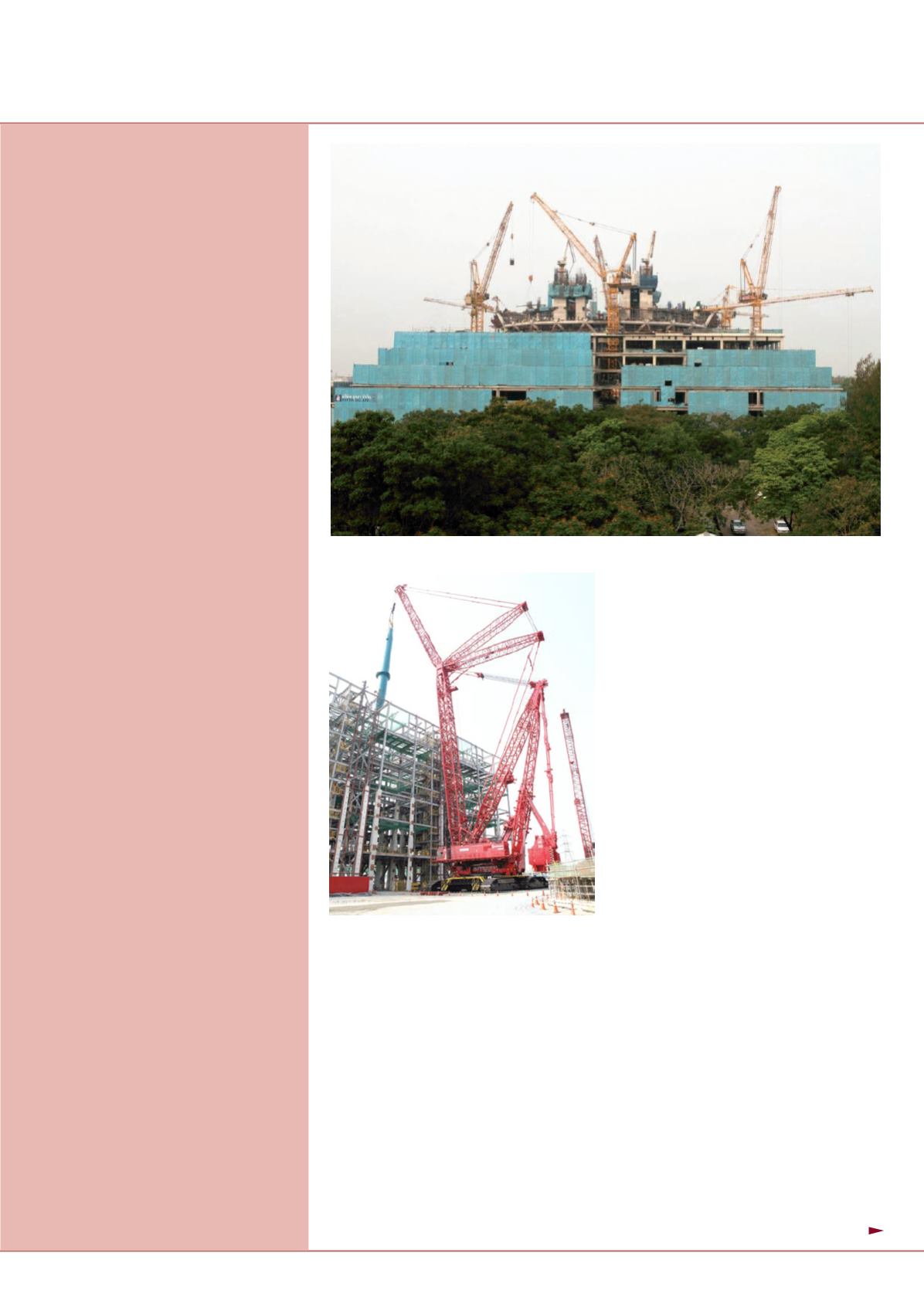
18
international
construction
Türkiye
Eylül
2013
Pasifik Asya
Bölge Raporu
English translation
Endonezya’da, Bayındırlık Bakanlığının
hesaplamalarına göre, hükümetin 20101-
2014 Beş Yıllık Ulusal Kalkınma Planı’nda
yer alan hedeflere ulaşmak için toplam
203 milyar $ altyapı yatırımı gerekiyor.
Bu yatırımın yaklaşık %29’unun merkezî
hükümet, %18’iin yerel idareler ve %18’inin
de kamu teşekkülleri tarafından karşılanması
planlanmakta. Geri kalan %35’lik bölüm
içinse özel sektörün katılımı bekleniyor.
Bayındırlık Bakanlığı, toplam değeri
33,2 milyar $’ı bulan, aralarında paralı
yollar, köprüler, su tedarik şebekeleri, atık
işleme tesisleri ve havaalanı yatırımlarının
da bulunduğu 21 KÖSO projesini öncelikli
olarak belirledi. İnşaat endüstrisindeki bu
büyüme, ağır makinelere yönelik talebi de
körüklemiş durumda. Bakanlık verileri,
2007’de 7.500 adet olan ağır inşaat makinesi
satış hacminin 2011’de 20.000 adede
çıktığını ortaya koyuyor.
Hatta Bakanlık, Endonezya’da ağır inşaat
makineleri bakımından bir arz darlığının
yaşandığına dikkat çekiyor. Hükümet, arz
ile talep arasındaki bu dengesizliği ortadan
kaldırma yolunda ithalata hızlandırmak
yerine, uluslararası üreticiler ve yatırımcıları
ülkede fabrikalar kurmaya teşvik edecek
adımlar atmayı yeğliyor.
AKB raporlarında, Endonezya
hükümetinin altyapı yatırımlarının önündeki
engelleri aşmak için başka önlemlere de
başvurduğunun altı çiziliyor. Altyapı
projelerinde belirsizlikleri azaltan yeni
istimlak düzenlemeleri örnek gösterilebilir.
Öte yandan, KÖSO projelerini desteklemek
üzere bir de finansla açık fonu oluşturuldu.
Yine de, hâlâ yapılması gereken çok iş
var. AKB, ülkede ilçe yollarının %41’inin
ve il yollarının %24’ünün kötü durumda
olduğunu tahmin ediyor.
Benzer biçimde, Kamboçya’da da ciddi
bir finansman ihtiyacı kendini hissettiriyor.
AKB’nin hesaplamalarına göre, ülkenin
büyüyen ekonomisinin gereksinim duyduğu
yeni altyapı projeleri için 12 ila 16 milyar
$ harcanması gerekmekte. Kamboçya
hükümeti, bu çerçevede KÖSO’lara daha
fazla ağırlık veriyor. KÖSO projelerine
yönelik yasal, kurumsal ve düzenleyici
ortamın iyileştirilmesi amacıyla, şeffaflığın ve
kalite düzeyinin yükseltilmesine odaklanan
sanctions. Work started June and is expected to
take 33 months to complete.
Momentum
There is strong momentum elsewhere in the
Asia Pacific, particularly when it comes to PPP
initiatives. In Indonesia, a total infrastructure
investment of US$203 billion is required to
maintain the targets of the government’s Five
Years National development Plan 2010-2014,
according to the Ministry of Public Works.
About 29% of this investment is planned to
be financed by the central government, 18%
by local government and 18% by state-owned
enterprises. But the remaining 35% is expected
to be financed by the private sector.
The Ministry of Public Works has identified 21
priority PPP projects worth US$33.2 billion. This
growth in construction has fuelled demand for
heavy equipment, sales of which jumped from
7,500 units in 2007 to 20,000 in 2011, according
to the Ministry of Public Works.
In fact, the Ministry has now highlighted a
shortfall in heavy equipment in Indonesia. To
address this supply/demand imbalance, it said
the government was promoting the country
as a place for international manufacturers
and investors to set up factories, instead of
importing equipment.
The ADB also highlighted other steps that
Indonesia is taking to overcome obstacles to
infrastructure development, including new
regulations regarding land acquisition that
provide more certainty for infrastructure
developments, while a viability gap fund has
also been established to support PPP schemes.
But there is much work to be done – the ADB
estimates that 41% of district roads and 24% of
provincial roads throughout Indonesia are in bad
condition, for instance.
Similarly, Cambodia also faces substantial
funding needs. Investment of between US$12
and US$16 billion is required to build new
infrastructure for its growing economy according
to the ADB. In view of this, the Cambodian
government is also putting more emphasis on
PPPs. It has an ambitious range of initiatives
under way to strengthen the legal, regulatory,
and institutional environment for PPP schemes
to be attractive, focussing on improving
transparency and quality. The first projects under
the new programme are expected to take shape
in 2013 and 2014, for implementation soon after.
Large infrastructure investments are also
planned for Thailand, where the government is
focussing on water management and transport
infrastructure in the wake of the severe
flooding that hit the country in 2011. According
to the ADB, the water management programme
should gather momentum from the second half
of 2013, with US$1.3 billion projected to be
spent this year.
Thailand’s government also plans legislation
under which it can borrow the equivalent of
US$67 billion off-budget over seven years to
invest in transport infrastructure. Major projects
currently underway include a US$1 billion
contract to construct part of a commuter rail
system in the Thai capital, Bangkok, which was
awarded to a joint venture led by Sino-Thai
>
Yüklenici firma RITTA Co, Tayland’ın Bangkok kentindeki Dhammakay Tapınağı’na eklenen yeni
ayin salonunun ön dökümlü beton parçalarını kaldırmak için dört adet Liebherr 540HC-L 12/24
Litronic bomu hareketli kule vinç kullanıyor
Güney Koreli kiralama şirketi Chunjo Construction
Co, Manitowoc’un bugüne dek imal ettiği en
yüksek kapasiteli paletli vinç modeli olarak dikkat
çeken Manitowoc 31000’i filosuna ekledi


